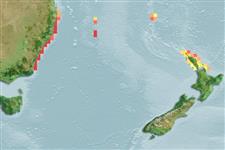Environment: milieu / climate zone / depth range / distribution range
Ekologi
marina; brackvatten; djupintervall 0 - 20 m (Ref. 6390). Temperate; 28°S - 37°S
Southwest Pacific: eastern Australia from Moreton Bay, Queensland to Eden, New South Wales, including Lord Howe and Norfolk Islands.
Size / Vikt / Age
Maturity: Lm ? range ? - ? cm
Max length : 39.8 cm SL hane/ej könsbestämd; (Ref. 10988)
Taggstrålar i ryggfenan (totalt): 0; Mjukstrålar i ryggfenan (totalt): 15-17; Taggstrålar i analfenan 0; Mjukstrålar i analfenan: 17 - 20; Ryggkotor: 56 - 58. Preorbital canal with a posterior branch. Relatively longer jaws, especially at larger sizes. Gill rakers usually 34 or more in the first arch and usually 27 or more on the second arch.
Found in sheltered bays, clear coastal waters and sometimes in estuaries (Ref. 27012). Generally herbivorous. Feed mainly on seagrasses and algal filaments (Ref. 26551, 27013). Eastern sea garfish also consume a high proportion of crustaceans (Ref. 27013). A schooling fish, found generally near the surface at night and close to the sea floor over seagrass beds during the day (Ref. 6390). They are being preyed upon by mulloway (Argyrosomus hololepidotus) and tailor (Pomatomus saltatrix), as well as coastal water birds. No studies have been reported on the spawning of this species (Ref. 6390).
Life cycle and mating behavior
Könsmognad | Reproduktion | Lek | Ägg | Fecundity | Larver
Viviparous.
Collette, B.B., 1974. The garfishes (Hemiramphidae) of Australia and New Zealand. Records of the Australian Museum 29(2):11-105. (Ref. 10988)
IUCN Red List Status (Ref. 130435)
Threat to humans
Harmless
Human uses
Fiskeri: kommersiell; bete: usually
Ytterligare information
referenserVattenbrukVattenbruksprofilAvelslinjerGenetikElectrophoresesÄrftlighetSjukdomarBehandlingNutrientsMass conversion
MedarbetareBilderStamps, Coins Misc.LjudCiguateraHastighetSimsättGälytaOtolithsHjärnstorlekSyn
Verktyg
Special reports
Download XML
Internet-källor
Estimates based on models
Preferred temperature (Ref.
123201): 18 - 23.4, mean 20.7 °C (based on 55 cells).
Phylogenetic diversity index (Ref.
82804): PD
50 = 0.5000 [Uniqueness, from 0.5 = low to 2.0 = high].
Bayesian length-weight: a=0.00257 (0.00115 - 0.00574), b=3.09 (2.91 - 3.27), in cm total length, based on LWR estimates for this Genus-body shape (Ref.
93245).
Trofisk nivå (Ref.
69278): 2.6 ±0.25 se; based on food items.
Resiliens (Ref.
120179): Hög, lägsta populationsfördubblingstid mindre än 15 månader (Preliminary K or Fecundity.).
Fishing Vulnerability (Ref.
59153): Low vulnerability (23 of 100).
